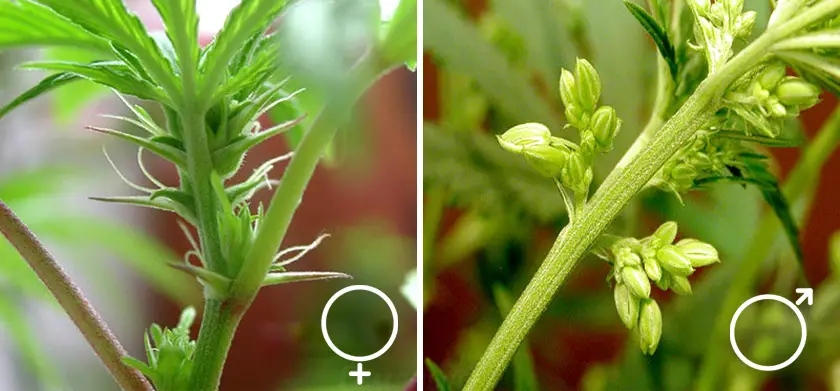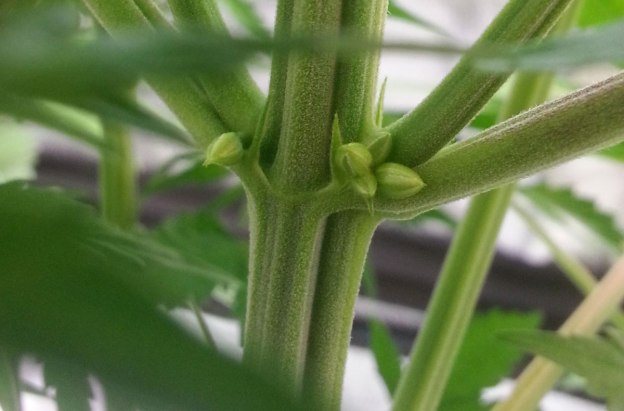Can you tell the gender of the plant in the pre-flowering phase? Yes, if you know some tricks. The male and female organs are visually distinct. If you look closely, you can see the characteristic features of each of them. How it is expressed and where exactly to look we will tell below and what are early signs of male plant and female plant.

early signs of male plant
What is hemp pre-color? These are small “patterns” of flowers in the bush, which are formed during the growing season, that is, these organs precede the flowers. They are very small, literally microscopic, but they become noticeable from the 3rd week of the plant’s life. Why is it so important to study them, and why would growers in principle be interested in these pre-flowers? It’s simple. It is quite possible to understand the sex of plant by the pre-color (cups). Even in the early stages of plant development, the mini-version of flowers on male and female bushes differs in appearance and in a number of ways.
Usually, a bud is formed on male plants, ready to open as early as 3-4 weeks after germination. Maturation of females comes later: they need about 4-6 weeks.
Why find out the gender? For budding growers, this is often a hot topic. This information is quite useful as powerful buds form exclusively on feminine flowers. For this reason, many growers try to identify and remove male plants early on (they only produce pollen sacs). You can’t get bumps from them. Moreover, they often negatively affect the formation of plant. The fact is that you can get a quality product from female bushes (without seeds, sinsemilla) only if they have not been pollinated, so it is important to protect them from contact.
Interesting: if feminized seeds are used for growth, then all the bushes will be female. In this case, there is no need to determine gender. But if growers use regular seeds, it can happen that half of the plant bushes are male. By the type of seeds, it is impossible to determine what kind of plant will turn out.
DETERMINE THE SEX OF PLANT
Usually, you can determine the sex of the plant as early as 3-6 weeks after germination. The nuance is that not everyone understands where to look in principle. The main features are located on the pre-flowers (calyx). They represent the rudiments of green flowers, covered with fine white hairs. By their appearance, it is quite possible to determine the gender of plants.
Cups are formed at the top of the bush. This position is not accidental, since in this case, they are closer to the light. It also happens that they appear on the branch from below, so you should carefully examine the bush. The shape of the female and male pre-flowers is similar, so the gender becomes clear closer to the 6th week of the growing season. Let’s figure out the differences.
You may also like Planting Lemon Seeds.
Signs of a male pre-color
Such plants show their affiliation a couple of weeks earlier: they can be determined as early as 3 weeks. The cups on the male bushes are shaped like spades (like on playing cards). The pre-blossom is very small. If there are doubts about the identification of his gender, then it is better to wait a week or two to consider how the organ will develop further.
The difficulty in identifying is that the pollen sacs sometimes look irregular. During flowering, male cups grow and turn into bunches, somewhat similar to grapes. This is one of the main distinguishing features. Another is the absence of white pistils (a sign of feminine flowers) on such pre-flowers.
early signs of female plant
The genitals on such bushes primarily differ in shape. They are longer and thinner in comparison with male pre-flowers, sometimes they have a thick base. For female cups, the characteristic feature is the presence of 1-2 pistils (white hairs). They are located at the top of the penis.
Interesting: pistils are not always visible from the first weeks. Sometimes it is necessary to wait a couple of days to find them (until they are revealed).
For female pre-flowers, small green growths are also characteristic, somewhat similar to hairs that intersect. On male bushes, the growths rarely intersect. Despite the fact that this feature is a kind of clue, it cannot be an exclusive feature of gender. Therefore, it is also worth paying attention to the presence of a pistil.
Interesting: the cups are necessary to hold the seeds during the pollination period. When the pollen spreads to the pistils, it immediately enters the “pouch”. Through this process, seeds begin to form.
Read also can plants reproduce sexually and asexually.
Is it possible to increase the number of female bushes
This is a question that plagues many growers, but scientists cannot provide a definitive answer. Some facts support that it is possible to predict the likelihood of male or female plant bushes. Growing conditions play an important role.

The following factors influence the formation of male organs:
- heatwave;
- irregular lighting;
- stressful conditions;
- interruptions in feeding and nutritional components.
Therefore, if you want to minimize the percentage of male plant bushes, you should carefully monitor the cultivation conditions.
It is possible to increase the number of female plants by selecting the following influencing factors:
- Healthy stuff. For sowing, seeds should only be used from selected bushes that have grown stress-free and have not been pollinated.
- Cool. Female plants don’t like heat. For their formation, seedlings need to provide a stable coolness throughout the day.
- Moisture. It is necessary to ensure that it is at least 50-70%.
- Blue lighting. The grove needs to be illuminated with special lamps (for example, metal halide). It is important that they form rays of the blue spectrum.
- Adequate food. the plant reacts especially sharply to the presence of nitrogen, but care must also be taken to ensure that there is no deficiency of other substances.
- Lack of stressful conditions. Any sudden jolt during the first weeks of growth affects the formation of the male plant.
In addition, you need to monitor the condition of the roots. Over-watering can cause rot, stressing the plant, limiting nutrition, or even killing the bush.
All of the above factors that can be used to “program plants” to form sex further support the claim that the environment has a direct impact on the formation of the plant and the quality of the crop. Therefore, you can experiment with landing.
It is interesting to note that the floor is completely formed by the 3rd week of the plant’s life. At this stage, it already lends itself to visual identification. However, if you take clones from plants obtained from regular seeds (provided that there are no obvious signs yet), then the probability of the appearance of the female and male plants is 50/50. After 3 weeks, the situation changes. As adults, the sex of the clones will always be the same. This feature once again confirms the fact of the influence of the external environment on the development of plants.